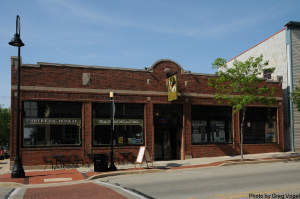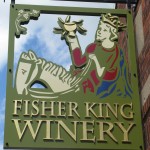Fisher King Creates a Legend in Wisconsin
Alwyn Fitzgerald named his winery Fisher King after the ancient legend of birth and rebirth. And September 2011 was the birth of something big for Alwyn ‘Fitz” Fitzgerald. That’s when he opened a converted plumbing store as Fisher King Winery in downtown Mount Horeb, Wis. Grapes delivered by local vineyards in the fall of 2011 were crushed and pressed at the Winery’s Mount Horeb facility, resulting in five out of the company’s ten wines being borne from locally grown Wisconsin grapes.
When Fisher King opened one year ago, the marquee product was Sesquicentennial Red, which was fermented at nearby Wollersheim Winery. Fitzgerald rushed to fill 14,000 bottles with the wine and opened Fisher King slightly later than expected. But sales surpassed expectations: After one year, the vintage is nearly depleted.
This dry Marechal Foch, with fruity flavors and an oak finish, was made with grapes grown eight miles away. The winemaker’s goal is to make 90 percent of his wines with locally grown grapes, and now his 10-wine menu includes four Wisconsin products. A fifth wine made from Wisconsin grapes, Fisher King Marquette, makes its debut in September.
‘I’m convinced we can make absolutely spectacular wines” with cold-hardy grapes, Fitzgerald says. His other Wisconsin-grape wines are White Whisper, a semi-dry white from Frontenac Gris and La Crosse grapes, and the reds Romantic Rogue, using Marechal Foch and Norton; Bountiful, a blend of St. Croix, Frontenac and Marechal Foch (plus a Washington-grown Cabernet); and the upcoming Marquette.
The Fisher King Marquette, made with Vernon County Wisconsin grapes, was fermented eight months in French oak before final filtration and balancing. It will be a limited release of no more than 400 gallons.
See related story: Grape Production Expands in Vernon County Wisconsin
Fitzgerald, a Vermont native with a biology degree and a master’s in business administration, moved to Wisconsin in 1985 and is a longtime wine connoisseur whose collection peaked with an 800-bottle cellar. He began making wine as a teen, and the hobby matured into an ongoing passion that involved University of California, Davis winery certification classes and mentoring from Alan Dillard, the retired winemaker of Rustle Hill Winery, Carbondale, Ill., and Philippe Coquard of Wollersheim Winery, Prairie du Sac. Wis.
Fitzgerald had decided five years earlier to grow one-half acre of grapes — a mix of Marechal Foch, Frontenac and Leon Millot. What did he learn? ‘Just about everything eats grapes and grapevines,” but his small vineyard continues and now also includes Marquette and St. Croix vines.
The crop is a tiny part of the Fisher King inventory. About 14 tons of grapes from Wisconsin growers in Vernon, Dane and Milwaukee counties will arrive by September. The compromised 2012 growing season means price increases of 5 to 10 cents per pound, which Fitzgerald considers slight, compared to earlier industry predictions.
Until 2008, much of his marketing work was with biotech and other science-based corporations. Then he set out on his own, as a Madison-based marketing consultant, but the work ‘wasn’t feeding my soul.” When he hit age 50, ‘I knew that if I didn’t do this now, it probably wouldn’t happen,” regarding winemaking as a career.
He wrote a business plan but could not obtain bank financing. He raided his retirement account and supplemented it with other avenues of revenue, including an $80,000 low-interest loan from the village of Mount Horeb and $150,000 from 26 private investors.
The shareholders make a six-year commitment to Fisher King and gain shares of equity, plus a swipe card for making winery purchases — a VIP perk whose value equals 25 percent of the investment. ‘It keeps investors engaged and reinforces a sense of ownership,” Fitzgerald says.
Although investors have voting rights, Fitzgerald retains majority ownership in his LLC and has the option to buy out investors at a set price. ‘The ownership structure gives me the flexibility to be creative,” he says.
Here are other examples of Fisher King’s creative thinking:
– In addition to selling wine by the bottle, glass and five-flight samples, customers purchase nibbles of award-winning and high-profile Wisconsin artisan breads, sausages, cheeses and chocolates. Brands include Sartori cheeses and Gail Ambrosius truffles.
– The go-local emphasis surfaces in additional ways. Fitzgerald hires local musicians and decorates with the works of local artists, including Gretchen Hedrick, whose paintings are reproduced as labels for Fisher King’s Chalice Riesling and Chalice Pinot Noir (made with Washington and Oregon grapes, respectively).
– Fitzgerald sold all of his oak barrels and instead uses 330-gallon, high-tech, gas-permeable Flextank storage systems, in which oak staves hang vertically to provide the wine’s oak flavor. ‘There are many reasons why I don’t like barrels,” he says. ‘They are costly, inefficient, take up tons of room and are hard to sanitize — but I like what oak can do to enrich the flavor of wines.”
 The winery was a car dealership in the 1960s, and the high ceilings of the former service bay made it easier to accommodate temperature-controlled fermentation tanks. Total tank capacity is 6,000 gallons. But Fitzgerald intends to increase the size of his tanks this because ‘my cost per bottle is still elevated.”
The winery was a car dealership in the 1960s, and the high ceilings of the former service bay made it easier to accommodate temperature-controlled fermentation tanks. Total tank capacity is 6,000 gallons. But Fitzgerald intends to increase the size of his tanks this because ‘my cost per bottle is still elevated.”
His decision to establish an urban winery was a matter of logic and reality: ‘In the classic approach, you’d inherit or buy acres of vineyards and add a château with a tasting room, but it takes a cool $3 to $4 million to create that (farm winery) model from nothing. I had no angel investor.”
The average profit margin for an urban winery is higher than the vineyard-based, he adds, and the urban business model is simpler: ‘What I have is a combination of retail and light manufacturing — it’s like food processing — and it would be too distracting for me to also add a farm model” to the equation
He calls Fisher King ‘the winery version of a brew-pub that brings in quality products” and a logical match for Mount Horeb. Although the community’s population barely exceeds 7,000, it is only 23 miles southwest of Madison and ‘met the wine consumer profile” — above-average income and education, visitor-oriented and en route to other tourist attractions.
[wp_geo_map]



